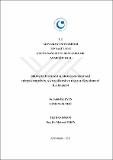Bronşiolitli hastalarda başvurudaki hiponatreminin, yatış süresi ve hastalığın şiddeti ile ilişkisi
- Global styles
- Apa
- Bibtex
- Chicago Fullnote
- Help
Abstract
Amaç: Orta ve ağır bronşiolit olgularında hiponatreminin hastanede yatış süresi ve apne, konvülziyon, entübasyon, ölüm gibi kötü sonuçlar ile ilişkili olduğu bilinmektedir. Ancak bildiğimiz kadarıyla hafif, orta ve ağır bronşiolit olgularının tümünde hiponatreminin etkisini inceleyen çalışma bulunmamaktadır. Bu çalışmada hafif-orta ve ağır bronşiolit tanısı ile hastanede yatan 1-24 ay arasındaki çocuklarda, başvurudaki hiponatreminin hastalığın şiddeti ve yatış süresi ile ilişkisinin araştırılması amaçlandı.Gereç ve yöntem: Çalışmamız Adıyaman Üniversitesi Tıp Fakültesi Çocuk Sağlığı ve Hastalıkları Anabilim Dalı'nda ileriye dönük olarak gerçekleştirildi. Çalışmaya 1 Mayıs 2017 ile 30 Nisan 2018 tarihleri arasında Süt çocuğu servisine akut bronşiolit tanısı ile yatışı yapılan, yaşları 1-24 ay arasında değişen 170 çocuk alındı. Hastaların yaş, cinsiyet, doğum şekli, yenidoğan döneminde entübasyon, beslenme şekli, tekrarlayan hışıltı, atopi öyküsü gibi demografik veriler ile solunum sayısı, kalp tepe atımı sayısı, oksijen ihtiyacı, bronşiolit ağırlık derecesi, yüksek akımlı nazal kanül (HFNC) ihtiyacı, entübasyon ihtiyacı, yatış süresi gibi klinik seyirle ilgili veriler ve biyokimyasal parametreler kaydedildi.Bulgular: Çalışmaya 170 hasta alındı. Hastaların 62'si (% 36,4) hiponatremik ve 108'i (% 63,6) normonatremik idi. Hiponatremik grupta 32 hasta (% 51,6) hafif, 13 hasta (% 20,9) orta ve 17 hasta (% 27,5) ağır bronşiolit tanısı alırken, normonatremik grupta 85 hasta (% 78,7) hafif, 14 hasta (% 12,9) orta ve 9 hasta (% 8,4) ağır bronşiolit tanısı aldı (p<0,001). Hiponatremik grupta 31 hastada, normonatremik grupta ise 23 hastada oksijen ihtiyacı vardı (p<0,001). HFNC ihtiyacı hiponatremik grupta; 17 hastada, normonatremik grupta ise; 9 hastada vardı (p=0,001). Ağır bronşiolit gelişme riskinin hiç anne sütü almayanlarda anne sütü ile beraber karışık gıda alanlara göre 9,855 kat, atopi olanlarda olmayanlara göre 0,037 kat ve hiponatremi saptananlarda saptanmayalara göre 0,085 kat arttığı tespit edildi. Hiponatremik grupta hastanede yatış süresi ortanca 5(2-21) gün iken normonatremik grupta 4(2-11) gün idi (p=0,001). Kız cinsiyetin yatış süresininin uzama riskini 0,4 kat azalttığı saptanırken, atopi öyküsünün yaklaşık 4,7 kat ve hiponatreminin yaklaşık 4,7 kat arttırdığı tespit edildi. Sonuç: Bu çalışmada hiponatremik grupta ağır bronşiolit gelişme riskinin normonatremik gruba göre anlamlı düzeyde yüksek olduğu ve hiponatremik grupta non-invaziv mekanik ventilasyon ihtiyacının daha yüksek olduğu saptandı. Hiponatremik bronşiolit tanılı olgularda yatış sürelerinin normonatremik olgulara göre daha uzun olduğu saptandı. Bu sonuçlara dayanarak, bronşiolit olgularında yatış sırasında sodyum değerlerinin belirlenmesinin ağır bronşiolit gelişme riski ve uzamış yatış sürelerini öngörmede faydalı olacağını düşünüyoruz. Anahtar sözcükler: Bronşiolit, Hiponatremi, Yatış süresi, Süt çocuğu Objectives: It is known that hyponatremia is associated with prolonged length of stay and worse outcomes such as apnea, convulsions, intubation, and death in patients with moderate to severe bronchiolitis. But to our knowledge, there is no study that examines the effect of hyponatremia in all cases of mild, moderate and severe bronchiolitis. In this study, it was aimed to investigate the relationship between the severity of the illness and the duration of the hospitalization of hyponatremia in children between 1-24 months of age with mild, moderate and severe bronchiolitis diagnosis.Materials and methods: Our study was carried out prospectively in Adıyaman University Medical Faculty Child Health and Diseases Department. Between May 1, 2017 and April 30, 2018, 170 children aged between 1-24 months who hospitalized to infant clinic with acute bronchiolitis were included in the study. Demographic data such as age, gender, type of delivery, neonatal intubation, nutritional pattern, recurrent wheezing, atopy, and data relating to the clinical course such as respiratory rate, heartbeat count, oxygen requirement, severity grade of bronchiolitic, high flow nasal cannula (HFNC) need, intubation need, duration of hospitalization, and biochemical parameters were recorded.Results: 170 patients were included in the study. 62 of the patients (36.4%) were hyponatremic and 108 (63.6%) were normonatremic. While in the hyponatremic group, 32 patients (51.6%) were mild, 13 patients (20.9%) were moderate and 17 patients (27.5%) had severe bronchiolitis, in the normonatremic group 85 patients (78.7%) were mild, 14 patients (12.9%) were moderate and 9 patients (8.4%) were diagnosed with severe bronchiolitis (p <0.001). There was oxygen requirement in 31 patients in the hyponatremic group and in 23 patients in the normonatremic group (p <0.001). HFNC therapy was required in 17 patients in the hyponatremic group and in 9 patients in the normonatremic group (p = 0.001). It was found that the risk of developing severe bronchiolitis increased by 9.855 times higher than those mixed food eaters with breast milk in those in cases who has never eaten breast milk, to be 0.037 times higher than those without atopy in those with atopy, to be 0.085 times higher than those without hyponatremia in those with hyponatremia. It was found that the risk of developing severe bronchiolitis increased by 9.855 times in the cases who has never eaten breast milk than those mixed food eaters with breast milk, and by 0.037 times in the cases with atopy than those without atopy, and by 0.085 times in the cases with hyponatremia than those without hyponatremia. The duration of hospitalization in the hyponatremic group was median 5 (2-21) days and in the normonatremic group was 4 (2-11) days (p = 0.001). While it was determined that female gender decreased the risk of elongation of the length of stay by 0.4 times, atopy history increased by about 4.7 times and hyponatremia by about 4.7 times.Conclusion: In this study, it was determined that the risk of developing severe bronchiolitis in the hyponatremic group was significantly higher than that of the normonatremic group and that the need for non-invasive mechanical ventilation was higher in the hyponatremic group. In the hyponatremic bronchiolitis cases, the duration of hospitaliation was longer than in normonatremic cases. Based on these results, we believe that the determination of sodium values during admission in bronchiolitis cases will be useful in predicting the risk of developing severe bronchiolitis and prolonged duration of hospitalization.Key words: Bronchiolitis, hyponatremia, length of stay, infant
Collections


